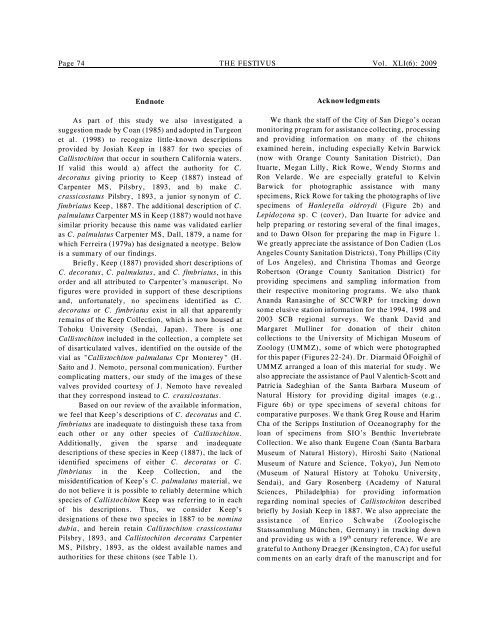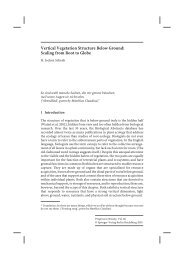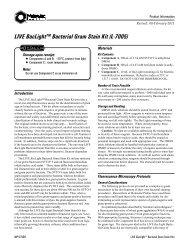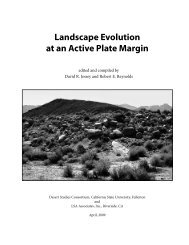Chitons (Mollusca: Polyplacophora) - Biological Science - California ...
Chitons (Mollusca: Polyplacophora) - Biological Science - California ...
Chitons (Mollusca: Polyplacophora) - Biological Science - California ...
You also want an ePaper? Increase the reach of your titles
YUMPU automatically turns print PDFs into web optimized ePapers that Google loves.
Page 74 THE FESTIVUS Vol. XLI(6): 2009<br />
Endnote<br />
As part of this study we also investigated a<br />
suggestion made by Coan (1985) and adopted in Turgeon<br />
et al. (1998) to recognize little-known descriptions<br />
provided by Josiah Keep in 1887 for two species of<br />
Callistochiton that occur in southern <strong>California</strong> waters.<br />
If valid this would a) affect the authority for C.<br />
decoratus giving priority to Keep (1887) instead of<br />
Carpenter MS, Pilsbry, 1893, and b) make C.<br />
crassicostatus Pilsbry, 1893, a junior synonym of C.<br />
fimbriatus Keep, 1887. The additional description of C.<br />
palmulatus Carpenter MS in Keep (1887) would not have<br />
similar priority because this name was validated earlier<br />
as C. palmulatus Carpenter MS, Dall, 1879, a name for<br />
which Ferreira (1979a) has designated a neotype. Below<br />
is a summary of our findings.<br />
Briefly, Keep (1887) provided short descriptions of<br />
C. decoratus, C. palmulatus, and C. fimbriatus, in this<br />
order and all attributed to Carpenter’s manuscript. No<br />
figures were provided in support of these descriptions<br />
and, unfortunately, no specimens identified as C.<br />
decoratus or C. fimbriatus exist in all that apparently<br />
remains of the Keep Collection, which is now housed at<br />
Tohoku University (Sendai, Japan). There is one<br />
Callistochiton included in the collection, a complete set<br />
of disarticulated valves, identified on the outside of the<br />
vial as "Callistochiton palmulatus Cpr Monterey" (H.<br />
Saito and J. Nemoto, personal communication). Further<br />
complicating matters, our study of the images of these<br />
valves provided courtesy of J. Nemoto have revealed<br />
that they correspond instead to C. crassicostatus.<br />
Based on our review of the available information,<br />
we feel that Keep’s descriptions of C. decoratus and C.<br />
fimbriatus are inadequate to distinguish these taxa from<br />
each other or any other species of Callistochiton.<br />
Additionally, given the sparse and inadequate<br />
descriptions of these species in Keep (1887), the lack of<br />
identified specimens of either C. decoratus or C.<br />
fimbriatus in the Keep Collection, and the<br />
misidentification of Keep’s C. palmulatus material, we<br />
do not believe it is possible to reliably determine which<br />
species of Callistochiton Keep was referring to in each<br />
of his descriptions. Thus, we consider Keep’s<br />
designations of these two species in 1887 to be nomina<br />
dubia, and herein retain Callistochiton crassicostatus<br />
Pilsbry, 1893, and Callistochiton decoratus Carpenter<br />
MS, Pilsbry, 1893, as the oldest available names and<br />
authorities for these chitons (see Table 1).<br />
Acknowledgments<br />
We thank the staff of the City of San Diego’s ocean<br />
monitoring program for assistance collecting, processing<br />
and providing information on many of the chitons<br />
examined herein, including especially Kelvin Barwick<br />
(now with Orange County Sanitation District), Dan<br />
Ituarte, Megan Lilly, Rick Rowe, Wendy Storms and<br />
Ron Velarde. We are especially grateful to Kelvin<br />
Barwick for photographic assistance with many<br />
specimens, Rick Rowe for taking the photographs of live<br />
specimens of Hanleyella oldroydi (Figure 2b) and<br />
Lepidozona sp. C (cover), Dan Ituarte for advice and<br />
help preparing or restoring several of the final images,<br />
and to Dawn Olson for preparing the map in Figure 1.<br />
We greatly appreciate the assistance of Don Cadien (Los<br />
Angeles County Sanitation Districts), Tony Phillips (City<br />
of Los Angeles), and Christina Thomas and George<br />
Robertson (Orange County Sanitation District) for<br />
providing specimens and sampling information from<br />
their respective monitoring programs. We also thank<br />
Ananda Ranasinghe of SCCWRP for tracking down<br />
some elusive station information for the 1994, 1998 and<br />
2003 SCB regional surveys. We thank David and<br />
Margaret Mulliner for donation of their chiton<br />
collections to the University of Michigan Museum of<br />
Zoology (UMMZ), some of which were photographed<br />
for this paper (Figures 22-24). Dr. Diarmaid ÓFoighil of<br />
UMMZ arranged a loan of this material for study. We<br />
also appreciate the assistance of Paul Valentich-Scott and<br />
Patricia Sadeghian of the Santa Barbara Museum of<br />
Natural History for providing digital images (e.g.,<br />
Figure 6b) or type specimens of several chitons for<br />
comparative purposes. We thank Greg Rouse and Harim<br />
Cha of the Scripps Institution of Oceanography for the<br />
loan of specimens from SIO’s Benthic Invertebrate<br />
Collection. We also thank Eugene Coan (Santa Barbara<br />
Museum of Natural History), Hiroshi Saito (National<br />
Museum of Nature and <strong>Science</strong>, Tokyo), Jun Nemoto<br />
(Museum of Natural History at Tohoku University,<br />
Sendai), and Gary Rosenberg (Academy of Natural<br />
<strong>Science</strong>s, Philadelphia) for providing information<br />
regarding nominal species of Callistochiton described<br />
briefly by Josiah Keep in 1887. We also appreciate the<br />
assistance of Enrico Schwabe (Zoologische<br />
Statssammlung München, Germany) in tracking down<br />
and providing us with a 19 th century reference. We are<br />
grateful to Anthony Draeger (Kensington, CA) for useful<br />
comments on an early draft of the manuscript and for
















